Flow Theory in Psychology: 13 Key Findings & Examples
 Have you ever been ‘in the zone?’
Have you ever been ‘in the zone?’
We all want to experience it. It’s intense, exhilarating, and satisfying. When we’re in the zone, or what researchers call ‘flow,’ we feel invisible.
The theory behind flow is as popular as ever with researchers investigating its effects in several areas of our lives. They’re looking at how flow affects us in sports, art, gaming, learning, and everyday athletics. The common thread in all of the research is one question:
How do we experience more flow?
Continue reading to learn the answer to that question, who can and can’t achieve flow, and why the experience of flow is important to us all.
Before you read on, we thought you might like to download our three Goal Achievement Exercises for free. These detailed, science-based exercises will help you or your clients create actionable goals and master techniques to create lasting behavior change.
This Article Contains:
- A Psychological Definition of Flow
- What is Flow Theory in Psychology?
- Flow and Happiness
- Flow and Positive Psychology
- The Research on Flow Theory
- 3 Interesting Findings
- 10 Examples of Flow in Psychology
- Flow State in Sports Psychology
- Motivation and Flow Theory
- A Look at Flow Theory in Education
- The Effect of Flow on Learning
- How to Apply Flow Theory in the Classroom
- What is the Flow Chart?
- 7 Books on Flow Theory
- Key Takeaways About Flow
- References
A Psychological Definition of Flow
Mihaly Csikszentmihalyi (Me-high Cheek-sent-me-high), the researcher who coined the term ‘flow’ discovered that people who experience flow tend to describe it similarly. There’s a feeling of timelessness. The task seems easy and things just “come together.”
He and his fellow researchers asked participants in their study to use pagers to communicate their thoughts and feelings at various times throughout their day. The initial study involved teenagers and while many reported unhappiness, Csikszentmihalyi noticed that when the teens were engaged in a challenging activity, their answers were more positive.
This type of tracking is called the Experience Sampling Method in which participants answer a series of questions about their experience at the moment the pager beeps.
Here’s how he explains flow and his research.
Our definition comes directly from Cziksentmihalyi’s book, ‘Flow: The psychology of optimal experience’ (2008).
“A state in which people are so involved in an activity that nothing else seems to matter; the experience is so enjoyable that people will continue to do it even at great cost, for the sheer sake of doing it.”
Notice that he says, “enjoyable.” Cziksentmihalyi makes a distinction between what is pleasurable versus enjoyable. The former are activities like sex, eating, watching TV, and sleeping. Examples of enjoyable activities are sports, recreational adventure, writing, art, and more. Flow experiences are active, while pleasurable experiences are typically passive and fleeting.
Flow is neither good nor bad. It simply is. Flow can lead to experiencing life more fully and intensely. We can experience more meaning. It also can strengthen how we define who we are (Cziksentmihalyi, 2009).
Positive and potentially negative behavior can lead to flow. For example, a gambler can get into a state of flow for a period of time. He’ll get “into the zone” watching the cards and interpreting his opponents’ behavior accurately, but flow states don’t last forever. At some point, the gambler will fall out of flow and likely lose. Obviously, the risk is greater in a gambling situation versus getting into flow while creating a piece of art, music, code, or writing.
The point is, not all flow situations are inherently good.
What is Flow Theory in Psychology?
To better understand Flow Theory, we need to know Csikszentmihalyi’s perspective regarding consciousness. He believes that we need to control our consciousness which in psychology is defined as:
“…the subjective experience of oneself and one’s environment. This experience includes the awareness of one’s feelings and emotions and the awareness of, and perceived control over, one’s thoughts and behaviors.”
For those familiar with Daniel Kahneman’s book, Thinking Fast and Slow, we can call this System 2 processing. As this happens, we formulate emotions and thoughts that eventually lead to action or inaction by our bodies. Without System 2, as Cziksentmihalyi (1990) points out, our instincts and reflexes (System 1) would take over.
Another way to look at this is, we need to control how we interpret the events that become a part of our conscious experience. If we do this successfully, then we are more likely to experience greater happiness, and therefore more flow.
What happens if we can’t control our subjective experience?
From Cziksentmihalyi’s (1990) perspective the most important tool that we can use to control our conscious experiences is attention. Our minds tend to lean toward the negative when idle. This is known as the negativity bias. We pay more attention to negative experiences and information and give them greater weight in our decision-making than we do positive or neutral information.
From an evolutionary perspective, this made sense because it kept us from being lion food or getting attacked by outsiders. Our negativity bias and System 1 still work that way for us, but sometimes they go into overdrive. (Speed Motors on FOX July 22, 2018)
System 1 is a speeding car without breaks. System 2 is the breaks and the parachute behind the car.
We have to consciously guide our minds toward what its focus should be at any given moment.
Where is consciousness?
Researchers at Harvard (2016) believe they’ve located where consciousness is in our brains. While studying coma patients they discovered a connection between a small part of our brainstem and two cortical regions. When that portion of the brainstem is damaged, a disconnection occurs between the cortical regions. This is important because we need both arousal and awareness in order to experience consciousness.
System 1 represents arousal and System 2 is awareness. Think of this as our internal “checks and balances” as we navigate our environment.
“Optimal states result when there is order in consciousness.”
M. Cziksentmihalyi (1990)
Flow is the complete immersion in an activity that you deem enjoyable in some way. This doesn’t mean that it’s not challenging. In fact, the activity must challenge you just enough to push you.
Your skills must be tested. Flow activities excite us, provide intrinsic rewards, and help us develop our skills.
Flow is a feeling of exhilaration and bliss.
A key component of getting into flow is that we’ve voluntarily accepted the challenge we’re attempting to solve. That’s part of what makes it deeply enjoyable.
In Cziksentmihalyi’s (1990) first edition of Flow: The psychology of optimal experience, he identified 9 ways through which we can achieve flow.
- Our bodies: Sex, dancing, and singing are a few examples. Later, Csikszentmihalyi (2008) classifies these as pleasurable, but not necessarily leading to flow.
- Our minds: Pushing ourselves to accomplish a difficult task like solving a math problem leads to satisfaction and enjoyment.
- Memories: Recalling enjoyable events allows us to relive our experience.
- Contemplating philosophical questions
- Communication: Conveying our thoughts to others and being understood can create a sense of profound enjoyment.
- Writing: This activity brings organization to our thoughts and is therefore enjoyable.
- Lifelong learning keeps us engaged in the activities we enjoy.
- A job: This works especially well if one is able to gamify one’s job.
- Solitude: Being comfortable alone with our thoughts can lead to exciting discoveries about the topics we find most enjoyable.
We can experience flow throughout our day, or sadly not at all. It’s a choice. That’s the beauty of finding flow.
Cziksentmihalyi (2008) also describes the theory as involving nine major components. To experience flow is to experience a sense of euphoria.
They are:
- The task is just outside our grasp, but we believe we can reach it.
- We’re able to focus all of our effort and attention on the task.
- Our goals are clearly defined.
- We receive immediate feedback (which includes course corrections.)
- Our time spent on the task seems effortless to us.
- We feel a sense of autonomy over our actions.
- Our focus isn’t on ourselves.
- The experience is timeless.
- The experience is autotelic.
What is meant by “autotelic?” Watch this short video for a quick explanation. (What is autotelic? What does autotelic mean?)
One way to stay in flow is to consistently increase the challenge as your skills improve.
Now that we know the basis for the theory, let’s dig into who can’t and who can experience flow.
Who has difficulty achieving flow?
- People who have psychiatric disorders like schizophrenia have difficulty because they can’t ignore distractions from external stimuli. They’re unable to distinguish between relevant and irrelevant information.
- Self-conscious people may lack the confidence necessary to pursue a challenging task.
- Self-centered people may lack the intrinsic motivation needed to doggedly pursue a challenge to completion.
- People who behave in ways that go against their goals (known as alienation) may not establish clearly defined objectives for their tasks.
- People who experience an environment in which the norms aren’t clearly defined may become confused.
Who can achieve flow?
The short answer is almost everyone. Even many of the people mentioned above can learn to achieve flow. Cziksentmihalyi (1990) asserts that no one is permanently disadvantaged by their genetics.
Young and old can achieve flow. Have you ever watched a child playing a new sport, bumbling about, but then she gets control of the ball and scores?
Think of a time when you were focused on an activity you liked. It probably took 15–20 minutes for you to get into “your zone,” but once you did, what happened? Maybe you were writing a short story or immersed in your favorite video game. Did you lose track of time? Did your writing come more easily to you? Were you able to reach higher and higher levels more rapidly?
People who experience flow regularly tend to be able to ignore irrelevant stimuli in their environments and enjoy themselves in a variety of situations because of their ability to filter. They also have more control over their thoughts. These individuals pay close attention to details which often helps them identify opportunities to act, set goals, gain feedback, and go after bigger challenges (Csikszentmihalyi, 1990.)
Flow and Happiness
The connection of flow to happiness is an important one. In his book, Csikszentmihalyi sums it up this way:
“One of the most frequently mentioned dimensions of the flow experience is that, while it lasts, one is able to forget all the unpleasant aspects of life.”
Mihaly Csikszentmihalyi, Flow: The Psychology of Happiness
Rogatko (2009) studied positive affect (PA) in a group of undergraduate college students in Japan. The objective was to determine if a causal relationship existed between PA and flow. Students were assigned to either a low or high flow activity. The results support the theory that flow leads to PA.
The pursuit of flow experiences is the pursuit of happiness, but this happiness is eudemonic in nature, not hedonic.
It’s important to note that a single flow experience doesn’t automatically lead to other flow experiences, but for someone who has a clearly defined goal it can. If the goal is challenging enough and other goals flow from it, then it’s more likely that the person will have more flow experiences in various areas of her life. Csikszentmihalyi (1990) calls this a “unified flow experience.”
This means that the person is devoting all of her energy to acquiring the skills necessary to achieve the larger goal. This puts her thoughts, feelings, and actions into harmony. Everything she does fits into her larger goal whether it’s in the present moment or upon review of past events, actions, and experiences.
Flow and Positive Psychology
The study of flow falls within the area of happiness in Positive Psychology research. There are numerous topics covered in positive psychology including resilience, creativity, positive emotions, strengths, and mindfulness. The researcher’s focus is driven by and concerned with how human beings thrive. Positive psychology researchers study how people lead meaningful and fulfilling lives.
Steven Kotler and Jamie Wheal are two men on a mission to explore the boundaries if there are any, of flow. They’re immersing themselves in the subject and working with several organizations and businesses to study ultimate human performance.
The Flow Research Collective is an interdisciplinary, global approach to tackling questions related to flow and peak performance in a variety of settings including businesses and schools.
The focus of some of their research is the potential connection of flow triggers to other positive psychology hot topics like mindsets, grit, and creativity, particularly in educational settings.
They designed a flow profile quiz to help people discover their own flow profile. It takes about three minutes to complete, you’ll be asked to give them feedback regarding training you’d like to see their organization offer, and then provide your email address before seeing your results. You’ll also receive emails introducing you to more ways to get into and stay in flow.
You’ll also have access to free videos and podcast episodes covering topics such as hacking the flow state, ultimate human performance, how flow drives creativity, and the dark side of flow. If you’re interested in more in-depth information, they offer a self-paced paid course called Flow Fundamentals.
The Research on Flow Theory
Researchers the world over are studying flow. No area of human experience is off limits. Here’s a glimpse into some of the research.
Sports
Research began being published in sports journals in 1992. Through repeated empirical studies, an association between flow and peak performance, especially among elite athletes, has been found. The psychological benefits of flow include “enhanced well-being and self-concept” (Swann, 2016).
There’s a plethora of research in sports. In the section titled, “Flow State in Sports Psychology” you’ll discover a few more examples.
Gaming
Developers and researchers are exploring how to create or improve upon the existing game design by incorporating the concept of flow theory. The primary question is how to increase a player’s enjoyment while simultaneously adding the appropriate level of challenges (Cowley, Charles, Black, & Hickey, 2008).
Another area of interest within gaming research is the possible relationship between game characteristics, flow, happiness, and addiction. Hull, Williams, & Griffiths (2013) found that the social element in many games is associated with higher levels of addictive-like experiences.
See, “The Effect of Flow on Learning” section below for more insights.
Art
Flow has been linked to creativity, but not specifically to art therapy. Chilton (2013) argues for the need to explore the connection between flow and art therapy asserting that one of the goals for therapists is to prepare the client to enter and exit the experience with as little disruption as possible.
Adventure recreation
MacKenzie, Hodge, and Boyes (2011) researched the potential connection between Reversal Theory (RT) and Flow Theory. Specifically, they wanted to know if people involved in adventure activities experience telic and paratelic flow, an RT concept. If so, then does flow vary between the two and can an integrated model of flow theory be developed through a combination of RT and flow theory constructs.
Telic flow is categorized as serious and outcome-oriented whereas paratelic is playful and process-oriented. In RT it’s the push/pull of opposing experiences like the above that create balance, and thus the experience of flow. Healthy individuals are able to satisfy opposing needs by engaging in “regular reversals” (MacKenzie, et al. 2011).
For example, the need for security versus the need for excitement. Because of RT’s basic premise, it’s positioned to explain the voluntary risk-taking behavior demonstrated by people involved in adventure activities.
Through their qualitative research, they concluded that flow theory could expand to include RT as a way to better explain the experience of different flow states within adventure activities. The role of telic and paratelic flow was supported. They also determined that learning and mastery influenced flow states. There appeared to be a potentially symbiotic relationship between states at different phases of the experience.
They acknowledged that due to the small sample size (11 qualitative/10 quantitative participants), limited activities included (six in study one/one in study two), and an inability to perform statistical analysis for n = 10, more empirical research is needed.
Learning
Researchers Rossin, Ro, Klein, & Guo (2009) sought to determine if a relationship existed between flow and learning outcomes for an online information management course.
They looked at objective learning performance, perceived learning of the subject matter, perceived skill development, and student satisfaction. Their findings “support a relationship between flow and students’ perceived learning of the subject matter, students’ perceived skill development, and student satisfaction.”
Martial arts
Kohoutkoval, Masaryk1, & Zdenko (2018) realizing that research in the area of flow and martial art training is limited, wanted to determine if a relationship existed between different aspects of training and the flow state. They studied skill acquisition, drill training, and sparring in Brazilian Jiujitsu.
Using a short version of the Dispositional Flow Scale (DFS-2) questionnaire they collected data from 136 participants. This questionnaire consists of nine questions corresponding to the nine dimensions created by Cziksentmihalyi.
Their results showed significant differences in the experience of flow between the three different areas.
Finding and remaining in flow is the “optimal experience,” according to Cziksentmihalyi and researchers are eager to discover all of the possible activities that can lead to it.
3 Interesting Findings
From research, several interesting conclusions have been made. We share a few that might surprise you.
1. Learn skills faster
Advanced Brain Monitoring used their APPT (Adaptive Peak Performance Trainer) to increase skill acquisition for novices in archery, golf, and marksmanship. In marksmanship, the participants in the novice condition improved an average of 28.60% compared to 12.22% for the control group (Berka, Behneman, Kintz, Johnson, & Raphael, 2010).
Watch Chris Berka’s TEDxSanDiego (2013) talk where she challenges the idea behind the 10,000-hour mastery concept. It might be a myth, according to her research. If you are someone who believes in the 10,000-hr idea but feels overwhelmed by the thought of trying to master a new skill, this might give you some hope!
Of course, mastery isn’t always the goal. Sometimes we just want to “be good” at a particular task. In that case, you might enjoy Josh Kaufman’s TEDxCSU talk, The first 20 hours — how to learn anything.
Whether you strive for mastery or “getting good,” both can lead to flow experiences.
2. The origins of consciousness
Remember those Harvard researchers from before? Their study identified three areas of the brain that may be involved in consciousness. Through their research with coma patients, they learned that the ventral anterior insula (AI), the pregenual anterior cingulate cortex (pACC), and the rostral dorsolateral pontine tegmentum (associated with arousal) are functionally connected in healthy adults.
When the pontine tegmentum is injured, as was the case in their coma patients, communication between the two cortical areas was disrupted. For us to experience consciousness, we need to have a connection between arousal and awareness. The AI and pACC are involved in awareness.
3. Open-office floor plans: Good or Bad?
For many years, businesses have designed their offices using an open floor plan. Their arguments for doing so are that it creates more communication and synergy among employees. It’s also less costly than individual offices or standard-size cubicles.
Several studies show that open-office designs are bad for employees, and as a result bad for business. Researchers Kim and Dear (2013) found that indoor environmental quality (IEQ) depended on the amount of enclosed workspace a person had, and that noise and privacy were cited most often as points of dissatisfaction.
In another study, Bernstein and Turban (2018) found that an open-office design decreased face-to-face contact (approximately 70%) but increased the use of email and IM. People withdrew from each other.
A study from Queensland University of Technology’s Institute of Health and Biomedical Innovation indicates that these types of offices increase stress, high blood pressure, conflict, and employee turnover.
If increasing synergy, a.k.a., flow within teams is one of the goals, open office designs appear to be missing the mark according to the research.
10 Examples of Flow in Psychology
The number of examples one could list is very long. Here are several to spark your thinking.
- A graphic artist creating a website illustration or logo
- A writer completing a 2000-word scene in an hour
- A musician composing a song while commuting to work on a subway
- A skier navigating a challenging downhill course seemingly effortlessly
- The creation of a soufflé by a chef
- Solving a Rubik’s Cube
- A pool player performing trick shots
- A pool player sinking all of their balls before their opponent steps up to shoot
- An hapkidoist executing expert joint locks
- A student studying for finals wearing noise-canceling headphones
Flow State in Sports Psychology
This is perhaps one of the most widely studied areas in positive psychology. How and when do athletes get “in the zone?” Most research is conducted using self-report surveys and the Experience Sampling Method (ESM) mentioned earlier and originally developed by Cziksentmihalyi.
Researchers have found a significant, positive relationship between intrinsic motivation and flow state among athletes. They’ve also learned that extrinsic motivation doesn’t significantly predict flow state (Kauffman, Soulliard, Perry, Montgomery, Hansen, Merz, & Ross, 2017).
Athletes and coaches want to find ways to get into flow faster and sustain the experience longer. This video provides useful information about flow, athletic performance, and a tool that could be used. (This isn’t an endorsement for their product. It’s simply an example of what could happen in the near future for athletes.)
Motivation and Flow Theory
Extrinsic motivation can be thought of as the “carrot and stick” approach to engagement in a task. Its effects are fleeting. As long as the person receives a reward and avoids a negative outcome, it works, but it does little to develop intrinsic motivation.
A prerequisite of attaining flow is voluntary engagement in a task that the person finds enjoyable. For tasks that are neither completely voluntary or enjoyable, the person may only work for satisfaction derived from external rewards.
When we’re in flow, we experience intrinsic motivation. We do whatever the task involves simply because it interests us, is enjoyable, provides a level of challenge that nearly matches our current skills, and for which we’re receiving immediate feedback.
Have you ever done a job and thought, “I’d do this even if they didn’t pay me?” You might be experiencing consistent and constant flow in that job. The satisfaction from doing the work motivates you to continue. You don’t need or care about recognition. It’s all about the work.
A Look at Flow Theory in Education
A survey conducted by Youth Truth between 2012-2017 that included 230,000 students in grades three through twelve, indicated that the majority of students feel engaged at school.
Sixty-eight percent of students in small schools (200 middle school — 300 high school students) reported being engaged compared to fifty-seven percent in large schools (800 middle school –1200+ high school). Smaller school size is associated with lower dropout rates, higher GPAs, better attendance, and higher graduation rates.
While numbers varied depending on level (elementary students were most engaged and high school students least) this is great news for flow researchers. An engaged student population is likely to experience more moments of flow.
Where are flow researchers focusing their attention?
Some researchers are curious about how flow can enhance student learning. It turns out that it can! Educational games are one way this is being studied. Why? Most students are already actively engaged in playing video games outside of school, and more teachers are using video games as part of their teaching.
More schools are investigating open-plan designs. These were popular in the 70s-80s in the United States, and by all accounts failed, but there’s renewed interest. Why? Administrators, educators, and parents want students to have more autonomy in their learning so that they’re even more engaged.
Montessori schools have been cited as excellent examples of this type of environment. You’ll read more about this in the next section.
The Effect of Flow on Learning
The idea of overlearning a task relates to flow. If you recall from the video above, our brains love repetition. That’s essentially what overlearning a task is, and when we do a thing repeatedly for a period of time, we’re more likely to experience flow.
Let’s return to those gaming researchers — rather than use the usual questionnaires and scales, some researchers are beginning to use EEG machines to objectively study what’s happening in the student’s brain while engaged in an educational gaming activity. This is because self-reports are subjective.
One of the objectives of researchers in this field is to create a flow environment. They want to know if a student can be guided into a flow experience. It’s not simply to determine if students experience flow while playing the game. When we’re in flow, our learning speeds up.
Take this example:
Researchers wanted to know the effect of flow on EFL learners’ vocabulary acquisition. They used the “Flow Perceptions Questionnaire,” to assess if a relationship existed. Their results indicated that flow existed in the classroom and that there was a significant relationship between the level of flow, and vocabulary retention in immediate and delayed measurements (Amini, Ayari, & Amini, 2016).
Are open-plan schools hurting students’ ability to achieve flow?
Given what research tells us about the negative effects of open-office designs, how does this affect students in a similar environment? Does flow become disrupted in open classroom designs, or does it encourage flow for students and teachers?
There’s been a resurgence of open-plan school designs in the past few years in the US and elsewhere. Proponents believe the closed classroom concept is archaic and that children need to be able to explore and learn at their own pace. Opponents point to research like what’s been mentioned in this article that shows the detrimental effects of open floor plans.
The most commonly studied issue is noise. Shield, Greenland, and Dockrell (2010) reviewed research spanning a 40-year period specifically related to this concern. The primary issue is noise coming from adjacent classes. They cite the need to install proper acoustic materials, the use of partitions, and coordinating with other teachers to minimize distraction.
According to Csikszentmihalyi in order to achieve flow a person must be able to focus her attention. This also is true in a classroom setting. The jury is still out on whether open plan schools will become a ‘thing’ again.
How to Apply Flow Theory in the Classroom
If you’re an educator, you might be curious how you can apply all of this great research to your work with students. Take a look at this short video explaining the theory and its implications for education:
Flow Theory’s focus on matching the skill level with the challenge level but ensuring that it’s just out of reach, is similar to Vygotsky’s Zone of Proximal Development (ZPD). Many educators learn about ZPD while studying to become a teacher, so this part of flow theory might seem familiar.
If you’re in an open-plan environment, consider reviewing the Shield, et al (2010) research. It includes specific information about decibel levels. Again, the primary concern is noise from outside your class base. Noise within was found to be similar in open and closed classroom designs and didn’t necessarily negatively affect student performance.
Here are a few more things you can do:
- Use more humor. When we’re laughing, we’re engaged in what’s happening.
- Help students see how what you’re teaching is relevant to their lives.
- Give students more autonomy over their learning. This idea is supported by motivational learning theories, particularly self-determination theory.
- Build positive relationships.
- Teach to the head, the heart, and the hands.
What is the Flow Chart?
According to Csikszentmihalyi’s research, and that of others later, when the level of challenge doesn’t match the person’s skill level, there’s little-to-no intrinsic motivation for engaging in a task. If there is a match, then intrinsic motivation increases, and flow can be experienced.
Several researchers have found that it’s the balance between challenges and skills plus the absorption in the activity, including clearly defined goals and immediate feedback that paves the way for a flow experience (Oliveira dos Santos, Silva, & Gomes, 2017; Magyarodi, Nagy, Soltesz, Mozes, & Olah, 2013).
Take a look at this chart:
To recap, here’s how psychology defines each of these items.
- Apathy is a mood or attitude that incorporates a lack of feelings, emotion, interest, and concern. It can include indifference or emotional suppression.
- Worry refers to the thoughts, images, and emotions of a negative nature in a repetitive, uncontrollable manner that results from a proactive cognitive risk analysis made to avoid or solve anticipated potential threats and their potential consequences (Borkovec, 2002)
- Anxiety is a strong and unpleasant feeling of nervousness or distress in response to a feared situation.
- Arousal is being alert, physically and mentally.
- Flow is a state in which people are so involved in an activity that nothing else seems to matter.
- Control is a belief that the individual is capable of influencing and making a difference in the events that surround their lives.
- Relaxation is a stress management technique that helps people reduce their level of physical and mental arousal.
- Boredom is an unpleasant, transient affective state in which the individual feels a pervasive lack of interest and difficulty concentrating on the current activity (Fisher, 1993).
If a person is closer to high on skill level, but low on challenge level, this can lead to apathy and possibly boredom.
7 Books on Flow Theory
Finding Flow: The psychology of engagement in everyday life – Mihaly Csikszentmihalyi
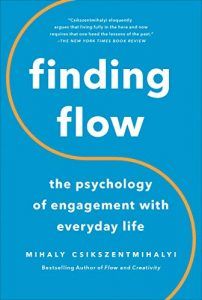
This book is a guide to recognizing and understanding how we can do that by increasing our experiences of flow.
By becoming completely engaged, even in the seemingly mundane, we can increase our happiness.
Find the book on Amazon.
Flow and the foundations of Positive Psychology – Mihaly Csikszentmihalyi
If you really want to be “in the know” about flow theory this is the book for you. It’s geared toward academics.
Topics include the Experience Sampling Model, attention, happiness, play and intrinsic rewards, motivation and creativity, flow, and positive psychology.
Find the book on Amazon.
Flow: The Psychology of Optimal Experience – Mihaly Csikszentmihalyi
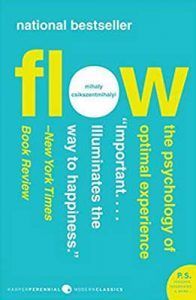
Every researcher, journalist, and blogger interested in flow starts here. You’ll learn in greater detail everything covered in this post.
This is an easier read than the previous one so if you’re looking for a quicker way to get to know this subject, begin here.
Find the book on Amazon.
The Rise of Superman: Decoding the science of ultimate human performance – Steven Kotler
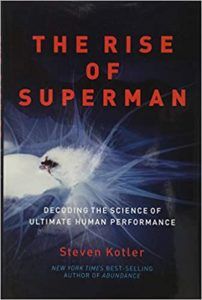
As a journalist, Kotler has spent considerable time talking with top performers and distilling their insights into actionable items for the rest of us.
Find the book on Amazon.
Stealing Fire – Steven Kotler and Jamie Wheal
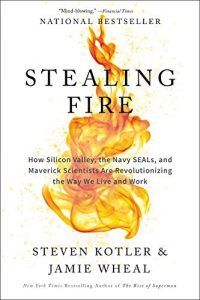
The objective is to show everyday people how to harness the knowledge gained in those fields and apply it to our lives.
Find the book on Amazon.
The Art of Happiness – His Holiness the Dalai Lama and Howard C. Cutler, M.D.
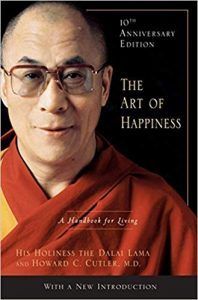
If you want a better understanding of how to deal with anxiety, insecurity, anger, and discouragement, this is your book.
Find the book on Amazon.
Deep Work: Rules for focused success in a distracted world – Cal Newport
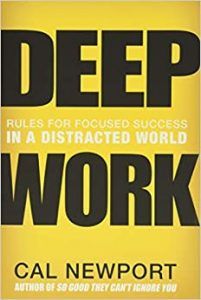
Flow requires an ability to close out distractions. This book illustrates how you can.
The author promises that you’ll “quickly master complicated information and produce better results in less time.”
Find the book on Amazon.
Key Takeaways About Flow
There’s a lot of great information about flow, but some important points to remember are:
- We can increase our flow experiences.
- Achieving consistent flow takes effort.
- Being ‘in flow’ contributes to our happiness.
- Technological advances are making achieving and sustaining flow easier.
- Teachers can positively influence the classroom atmosphere to foster more opportunities for flow.
- Uninterrupted time to concentrate on a task is necessary for us to experience flow.
I hope this article gave you a good overview of the psychology and theory behind flow and useful tips about how you can achieve more flow in your daily life.
Bookmark this page as an easy way to refer back to all of the strategies you can use to increase being ‘in the zone.’
Let us know how you do it! Thank you for reading.
We hope you enjoyed reading this article. Don’t forget to download our three Goal Achievement Exercises for free.
- Amini, D. & Ayari, S., & Amini, M. (2016). The effect of flow state on EFL learners’ vocabulary learning. International Journal of Multicultural and Multireligious Understanding, 3 (5), 9–18.
- Audiopedia (2017, Dec. 24). What is autotelic? What does autotelic mean? Retrieved January 8, 2019, from https://youtu.be/Yk–CJedMls
- Berka, C. (2014, Feb. 4). What’s next — A window on the brain. TEDxSanDiego. Retrieved January 9, 2019, from https://youtu.be/rBt7LMrIkxg
- Behneman, A., Berka, C., Kintz, N. Johnson, R. & Raphael, G., (2010). Accelerating training using interactive neuro-educational technologies: Applications to archery, golf, and marksmanship. The International Journal of Sport and Society, 1. Retrieved January 9, 2019, from https://advancedbrainmonitoring.app.box.com/s/xepjwff3zs001gbif8bc
- Bernstein, E.S. & Turban, S. (2018). The impact of the ‘open’ workspace on human collaboration. 373. Philosophical Transactions of the Royal Society B: Biological Sciences.
- Borkovec, TD. (2002). Life in the future versus life in the present. Clinical Psychology: Science and Practice. 9, 76–80.
- Chilton, G. (2013): Art Therapy and Flow: A Review of the Literature and Applications, Art Therapy. Journal of the American Art Therapy Association, 30:2, 64–70 (4). Retrieved January 21, 2019, from https://www.researchgate.net/publication/283912540_Art_Therapy_and_Flow_A_Review_of_the_Literature_and_Applications.
- Cowley, B., Charles, D. Black, M., and Hickey, R. (2008, July). Toward an understanding of flow in video games. ACM Comput. Entertain. 6, (2). Retrieved January 21, 2019, from https://www.researchgate.net/publication/235428533_Toward_an_understanding_of_flow_in_video_games.
- Csikszentmihalyi, M. (2014). Flow and the foundations of positive psychology: The collected works of Mihaly Csikszentmihalyi. New York, NY: Springer Dordrecht Heidelberg
- Csikszentmihalyi, M. (2008). Flow: The psychology of optimal experience. 1st ed. New York, NY: HarperCollins Publishers.
- Csikszentmihalyi, M. (1990). Flow: The psychology of optimal experience. 1st ed. New York: Harper & Row. Retrieved January 20, 2019, from https://www.researchgate.net/publication/224927532_Flow_The_Psychology_of_Optimal_Experience
- Fischer, D.B., Boes, A.D., Demertzi, A., Evrard, H.C., Laureys, S., Edlow, B.L., Liu, H., Saper, C. B., Pascual-Leone, A., Fox M. D., & Geerling, J. C. (2016). A human brain network derived from coma-causing brainstem lesions. Neurology, 87 (23) 2427–2434;
- Fisher, C.D. (1993). Boredom at work: A neglected concept. Human Relations. 46(3): 395–417.
- Hull, D. C., Williams, G. A., & Griffiths, M. D. (2013). Video game characteristics, happiness and flow as predictors of addiction among video game players: A pilot study. Journal of Behavioral Addiction, 2(3): 145–152.
- Kauffman, J. (2013, Mar 14). The first 20 hours: How to learn anything. Retrieved January 10, 2019, from https://youtu.be/5MgBikgcWnY
- Kim, J., and Dear, R. (2013). Workspace satisfaction: The privacy-communication trade-off in open-plan offices. Journal of Environmental Psychology, 36, 18–26.
- Kohoutkoval, J., Masaryk1, P., & Zdenko, Z. (2018). The Experience of the State of Flow in Brazilian Jiu-Jitsu. Journal of Martial Arts Anthropology, 18(3), pp. 1–6
- Kotler, S. (2014, Feb. 21). Flow and ultimate human performance: The rise of Superman. Retrieved January 10, 2019, from https://youtu.be/PtRl1W_KkYw
- Magyarodi, T., Nagy, H., Soltesz, P., Mozes, T., & Olah, A. (2013). Psychometric properties of a newly established flow state questionnaire. The Journal of Happiness & Well-Being, 1(2), 89–100.
- Newport, Cal (2016). Deep Work: Rules for focused success in a distracted world. 1st ed. New York, NY: Grand Central Publishing
- Oliveira dos Santos, W., Gomes, T., Silva, C. (2017). Toward a flow state identification in educational games: An empirical study. Brazilian Symposium on Computers in Education. Proceedings of the SBIE.
- Oliveira, H., Gomes, V., Miranda, R. (2015). The flow state in young basketball players. Psicologia em Estudo, 20 (1), 95–106.
- Psychology Research and Reference (n.d.). Retrieved January 20, 2019, from https://psychology.iresearchnet.com/social-psychology/social-cognition/consciousness/
- Rogatko, T.P. (2009). The influence of flow on positive affect in college students. Journal of Happiness Studies, 10(2), 133–148.
- Science Alert (n.d.). Office life is bad for your health. Retrieved January 20, 2019, from https://www.sciencealert.com/office-life-is-bad-for-your-health
- Shield, B., Greenland, E., & Dockrell, J. (2010). Noise in open plan classrooms in primary schools: A review. Applied Aspects of Auditory Distraction. Noise & Health, a bimonthly Inter-disciplinary International Journal, 12(49), 225–234.
- Speed Motors (2018, July 22). John Force scores 149th career Funny Car victory | 2018 NHRA Drag Racing. Retrieved January 20, 2019, from https://youtu.be/zvfwTHgbmdE
- Spencer, J. (2017, Dec. 3). What is flow theory? What does it mean for our students? Retrieved January 9, 2019, from https://youtu.be/iUsOCR1KKms
- Swann, C. (2016). Flow in sport. In L. Harmat, F. Orsted. Andersen, F. Ullen, J. Wright & G. Sadlo (Eds.), Flow Experience: Empirical Research and Applications (pp. 51–64). Switzerland: Springer International Publishing.
- Ulrich, M., Keller, J., Hoenig, K., Waller, C., & Gron, G. (2013). Neural correlates of experimental induced flow experiences. NeuroImage, 86, 194–202
- Wikipedia, (n.d.) Csikszentmihalyi, M. Flow Chart, revised. Retrieved January 9, 2019, from https://en.wikipedia.org/wiki/File:Challenge_vs_skill.svg
- Youth Truth Survey (2017) Retrieved January 21, 2019, from http://youthtruthsurvey.org/wp-content/uploads/2017/12/YouthTruth-Learning-from-Student-Voice-Student-Engagement.pdf
- Yun, K., Wu, D., Carrus, E., Doh, S., & Shimojo, S. (2017). Being in the zone: Flow state and the underlying neural dynamics in video game play.
Let us know your thoughts
Read other articles by their category
- Body & Brain (42)
- Coaching & Application (54)
- Compassion (26)
- Counseling (50)
- Emotional Intelligence (24)
- Gratitude (18)
- Grief & Bereavement (21)
- Happiness & SWB (40)
- Meaning & Values (25)
- Meditation (20)
- Mindfulness (44)
- Motivation & Goals (43)
- Optimism & Mindset (32)
- Positive CBT (25)
- Positive Communication (20)
- Positive Education (45)
- Positive Emotions (30)
- Positive Leadership (14)
- Positive Psychology (32)
- Positive Workplace (33)
- Productivity (16)
- Relationships (41)
- Resilience & Coping (34)
- Self Awareness (20)
- Self Esteem (36)
- Software & Apps (13)
- Strengths & Virtues (30)
- Stress & Burnout Prevention (34)
- Theory & Books (44)
- Therapy Exercises (35)
- Types of Therapy (58)

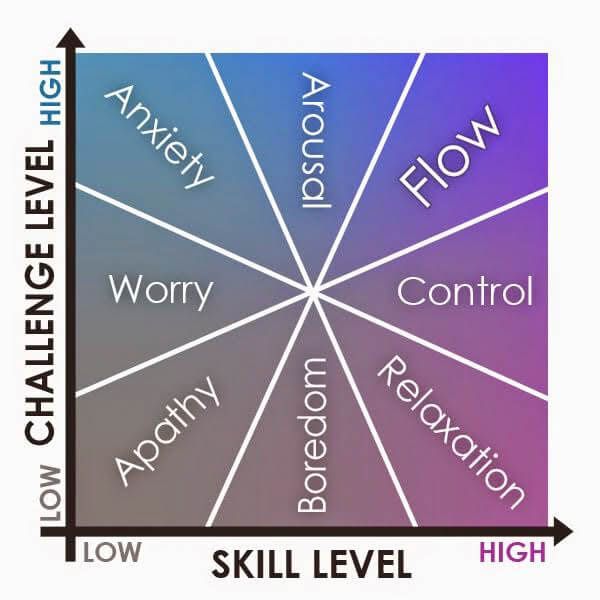
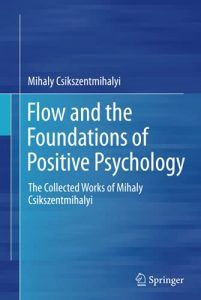



What our readers think
I spent much of my early life in ‘The Zone’ (up to age 42)
Its a place where everything pans out, you move ahead whilst achieving one success after another.
There is no doubt attached to decisions you make, and you take on bigger and bigger rational and ultimately successful challenges..
The universe appears to support you as you move through the various successes
I don’t have much of an education, I relied on my manual skills, gained whilst I was taking challenges on.
It was as if I was being guided and supported..
I have left out the detail deliberately as its a long story and merely wanted to respond to the article
I experience Flow while solving cryptic crosswords, when they are of medium difficulty. That’swhy many times, I suggested to the setters to set only medium diffulty puzzles, so that the solvers experience Flow , which generate more interest and Aha! feeling in their mind. Am I correct ?
Another thing I want to ask is, whether a continuous Flow experiences will result in the addiction of the activity ?
Hi Prasad,
That sounds like a great recommendation. When people find a puzzle difficulty that allows them to feel a sense of “aha!” or satisfaction upon discovery of the solution, that’s much more likely to bring about a state of flow than a puzzle that is too simple or so difficult that it’s frustrating.
Regarding your second question, there is some evidence linking flow experiences to addiction. Work in this space has looked a lot at video games. For instance, it’s been found that when a digital environment invokes a sense of presence (i.e., a feeling that a person is really ‘in’ the game, rather than technology mediating the interaction), this can lead to an increased risk of addiction, which is mediated by the flow experience (Park & Hwang, 2009).
There doesn’t seem to be as much work about flow leading to addiction outside of digital environments. So perhaps that points to an increased risk here stemming from the highly immersive nature of technology.
Hope that answers your question!
– Nicole | Community Manager
Flow of state is a great discovery from Cziksentmihalyi. I would like to know whether has any study or research apply flow theory on the clinical application such as depression and anxiety etc.
Hi Ka Shing Yu,
Generally, flow experiences are thought to be drivers of positive psychological states, such as flourishing and thriving (e.g., see Esche, 2021). The idea of flow coming into the treatment of depression fits in well with a behavioral activation style of treatment. This involves encouraging clients to schedule pleasurable activities, so they can feel the positive emotions that flow from them to help elevate mood (you can read more here).
Flow activities may certainly form an important part of a BAT activity schedule.
As for anxiety, there appears to be less research on this! So it’s harder to comment on, but research by Baker, Rickard, Tamplin and Roddy (2015) seems to suggest that reported flow experiences don’t directly affect reported anxiety.
– Nicole | Community Manager
I have been an early childhood educator for 30 years and I’ve done a lot of action research about how to teach writing in grades K-2. I am fascinated by the idea of curriculum that includes “flow”, in other words the lessons have entry points for novices and can also stretch to challenge kids who are already experts. I have seen an entire classroom of 28 kids all in a state of flow using lessons I have designed. Another adult can enter the room and everyone is silent and totally engaged and don’t even look up. It’s magical. It does not have to start from doing something they love – I’ve seen kids who hated writing at first become able to get into a flow with it where they don’t want to stop. If all curriculum had a flow design imbedded within, education would be more equitable, students would be more on task, and teachers would love their jobs more than they do now. I would love to have educational or flow researchers take a look at this area. Please contact me if you know anyone who would like to collaborate!
Book about finding more Flow for managers and leadership developer via modern training tools: https://www.amazon.com/Missing-Link-Discovered-Csikszentmihalyis-Flow-Leadership-ebook/dp/B01N1SAC9Z
Great compilation and let me also share Csikszentmihalyi’s official (!) Flow -Leadership Development Program and Serious Game FLIGBY http://www.fligby.com and the related professional blog site: http://www.flowleadership.org –
Dr. Zoltan Buzady, Associate Professor and Expert in Flow-Leadership, Academic Director of the Leadership & Flow Global Research Network
Hi… thank u for your paper. I’ve been practicing the flow for bout a year now, not knowing it was getting psychological attention. Super flow is my goal… and every now and then do. Only thing my focus is spiritual… becoming one w the Holy Spirit and gleaning the love grace and hope that is not just euphoria, but peace beyond understanding. I can achieve anything as long as the motive is righteous.
Peace
Flow: A Simple Explanation
Flow is a felt state of pleasure and attentive arousal that is elicited when one is focused on highly engaging behavior, from creativity to extreme sports, while in a relaxed or non-stressed state. In the brain, attentive arousal is mapped to the activity of mid-brain dopamine systems (arousal), and relaxation elicits the activity of opioid systems (pleasure). Since the nuclei (neuronal groups) for both systems abut each other in the midbrain, and since opioid and dopamine systems can mutually stimulate each other (opioid/dopamine interactions), this logically results in highly pleasurable and attentively aroused state, or ecstasy.
And that’s what flow is. For a more detailed (and still simple explanation), see pp. 82-86 on the linked treatise on the psychology of resting states. also at doctormezmer.com
https://www.scribd.com/doc/284056765/The-Book-of-Rest-The-Odd-Psychology-of-Doing-Nothing
have any negative effects been found with the usage of flow?
Hello, Jake. Thanks for reading the article. As to your question, here’s an article that might interest you: The Dark Side of Flow: A Qualitative Study
of Dependence in Big Wave Surfing.